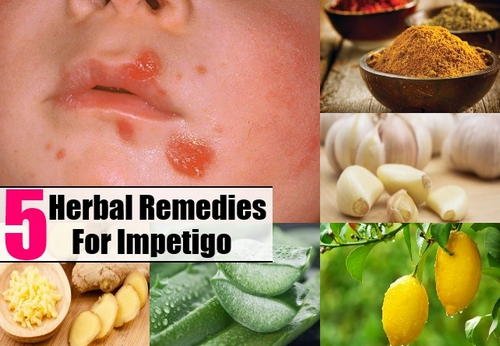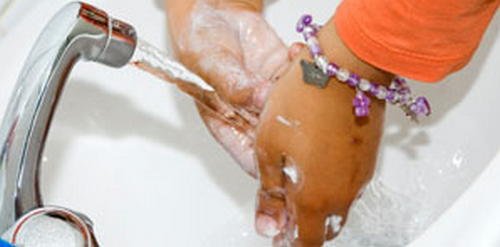What is infantigo/impetigo?
An infantigo/impetigo is a bacterial skin infection. It commonly affects the superficial layer of the skin, but a severe type can significantly affect the deep layer of the skin.
It is an infection commonly associated with infants and children, although, it can also affect adults. An infantigo usually does not cause lasting damage to the skin, but it can be severely unsightly and highly contagious. A person with infantigo should be isolated to make sure that he/she will not infect others. (1, 2, 3)
Image 1: Infantigo targets infants and children, although, in rare instances, can affect adults too.
Picture Source: emedicalupdates.com
Are there any other names for infantigo?
Infantigo is also known as impetigo (typos – infitago, infentigo, enfantigo, infetigo, infentago, infantago) impetigo vulgaris, and school sores. Do not be confused when these terms are used for they are all the same thing. (3)
What are the signs and symptoms?
Infantigo starts as a sore it is most commonly seen on the face, specifically on the nose and mouth. At first, the presentation is in the form of yellowish to honey-colored crust and after some time could turn to red colored sores.
Aside from the face, the sores may also be observed on other areas of the body such as the arms and legs. In severe cases, the patient may have severe blisters on the sensitive parts of the body such as the armpit and groin. The blisters caused a lot of pain and discomfort, not to mention, they are itchy too. (4, 5, 6)
Characteristics of infantigo lesions
- Appears as red sores or blisters.
- Once the sores/blisters burst, they leave crusts and then turn to patches that are golden brown in color. (8)
- The lesions can spread to other parts of the body.
- The lesions are itchy and painful. (7)
Who are at risk for infantigo?

Photo 2: Infantigo is common in children because of their playful personality and infection risk in the day care facility.
Picture Source: upload.wikimedia.org
An intact skin is the first line of defense. It protects us from infection. However, if the skin is broken, various pathogens may enter into the skin, which causes infection. The risk for infantigo and skin infection alike is high if the patient has several mosquito bites, herpes, eczema, wounds, and scabies. Other factors that could increase your risk for infantigo include the following:
- Living in a crowded place – If you are living in an extremely overcrowded place, there is a high possibility of having infantigo and other forms of infectious disease.
- Age – Infantigo is more likely common in infant and children than adults.
- Poor nutrition – A healthy body protects you from various types of diseases and illnesses. If your body lacks essential nutrients, your body won’t be able to fight infection.
- Contact sports – Transmission of disease is most likely to happen in people who are into contact sports such as wrestling, football, and basketball.
- Diabetes mellitus – Diabetic patients are prone to skin infections considering the fact that their wound heals slowly. Hence, if they have infantigo, the skin lesions tend to last longer than people without diabetes.
- Day-care – Those in the day-care community are prone to infantigo primarily because infantigo targets school age children and are most likely to occur in crowded place. Not to mention, kids are playful, which makes the transmission easy for school age kids. (9, 10, 11, 12)
What causes infantigo?
There are two primary causes of infantigo: Staphylococcus aureus and Streptococcus group A bacteria. These bacteria are commonly found on the skin but in small amount. They are natural skin flora.
However, if the number grows out of control along with a broken skin, infection could possibly take place. Both Strep and Staphylococcus bacteria are highly contagious. (11, 12, 13)
What does infantigo look like : Picture
Image 3: A comparison image between a bullous and non-bullous infantigo.
Picture Source: images.medicinenet.com
Different forms of infantigo
- Non-bullous – It starts with a single macule/papule and transitioned into vesicle in just a short period of time. It commonly affects the face, extremities, and areas that are prone to environmental trauma.
- Bullous – it is commonly seen in neonates and children. The causative agent is Staphylococcus aureus. The lesions are commonly found on moist areas of the body such as neck folds, axillar, and diaper area. (13, 14)
Infantigo affects people differently
- Newborn – Impetigo in newborn is extremely dangerous considering that newborns have under developed immune system. If not treated right away could lead to death.
- Children – Infantigo is more common in children, specifically two to six years of age. The clinical manifestations are prominent on the face, especially on the areas around the nose and mouth.
- Adults – In adults, impetigo usually occurs along with other skin conditions such as eczema. Those who had upper respiratory tract infection may also be prone to infantigo.
- Impetigo during pregnancy – If you are pregnant and you have impetigo, you have to be very cautious when taking antibiotics. The doctor usually prescribe topical antibiotic to make sure that the baby inside your womb will not be affected. Oral antibiotics may cross the placenta barrier, which may have untoward side effects to your growing baby. To be safe, you should use only natural remedies. After all, it is just a skin deep infection and will not affect your baby in any ways. (15, 16, 17)
Incubation period and mode of transmission
The incubation period of infantigo depends on the causative agent. If it is caused by Staphylococcus aureus, the incubation period is usually 1 to 3 days. For Streptococcus pyogenes, the incubation period is a bit longer, which is typically 10 days.
What does this mean? It means that once you get in contact with the causative agent, the infection would take several days before manifesting.
Infantigo, being a highly contagious disease can be transmitted through the following route:
- Getting in contact with another person who has an active infantigo infection.
- It can be transmitted through skin to skin contact/direct contact.
- It can be transmitted through indirect contact such as sharing toys, towels, and linens of an infected person.
- You can be exposed to infection through nasal secretion such as patients with active upper respiratory tract infection. (17, 18, 19)
Is impetigo contagious?
If you have active infection, then it is highly likely that you will infect other people, especially those with weak immune system. You are less likely contagious after 48 hours of starting antibiotic treatment prescribed by your doctor. If you don’t get treatment, you’ll be able to find out if you are non-contagious by simply looking at the lesions. They should be dry out and crust over. (4, 5, 6)
What are the possible complications?
Untreated severe impetigo cases could lead to serious complications which include but not limited to scarring, cellulitis, and kidney-related disease. (7, 8)
How to diagnose impetigo?
An infantigo disease needs a battery of test to positively confirm the condition. The doctor/health care expert performs the following procedures:
- Physical examination – The doctor thoroughly and carefully checks the sores and their location. Both subjective and objective cues will be thoroughly observed.
- Culture and sensitivity – This special procedure is performed when the doctor suspects Methicillin-resistant Staphylococcus aureus (MRSA) infection. It is also performed in patients with poststreptococcal glomerulonephritis (PSGN). (9, 10, 11)
Infantigo Treatment

Photo 4: Topical and oral antibiotics for impetigo.
Picture Source: www.shishibaogao.com

Image 5: Plants and herbs extracts are helpful in the treatment and management of impetigo and other types of infections.
Picture Source: www.healthcareatoz.com
What is the best cure for infantigo?
Impetigo treatment is available in various forms. The treatment approach primarily depends on the severity of case and the nature of infection. Of course, the age and general condition of the patient should be taken into considerations too.
Managing impetigo using antibiotics
There are various types of antibiotics to choose from, but the most effective ones are those that target the causative agents of infantigo such as Staphylococcus aureus and Streptococcus pyogenes. Antibiotics are introduced to the body in two ways:
Oral antibiotics
The doctor prescribes oral antibiotic if the infection is widespread. It is also the preferred route if the patient is not responsive to topical antibiotics. The typical drug of choice for infantigo includes cephalexin, cephalosporins, clindamycin, and erythromycin.
Cephalexin is ideal for treating impetigo in children while erythromycin is best for patients who are allergic to penicillin. For the antibiotic treatment to be effective, the patient should religiously take it for seven days. Once the patient starts with antibiotic therapy, he/she becomes non-contagious after 24 to 48 hours.
- Precautions: Some oral antibiotics cause undesirable effects such as nausea, vomiting, and diarrhea.
Topical antibiotics
For localized and less severe case of infantigo, a topical antibiotic can help clear the infection. However, it is not that effective in getting rid of bacteria in the respiratory tract. One particular topical antibiotic that can help clear nasal carriers is mupirocin ointment. Its effect is the same to that of the oral cephalexin. Other topical antibiotic choices for infantigo include sodium fusidate and retapamulin.
- Precautions: Topical antibiotics may cause undesirable effects such as itching, redness, and irritation. If the topical antibiotic prescribed by your doctor is causing a lot of discomfort, then you need to speak to your doctor. He/she might give other alterative drugs.
Natural remedies
Mild cases of infantigo can be treated using natural remedies or the things that commonly found in nature or right in the comfort of your home. Effective home remedies for infantigo include the following:
- Tea tree oil – Its antibacterial property makes it perfect in treating skin infections like infantigo. In fact, it is effective in treating severe impetigo. The antibacterial property helps get rid of bacteria while its anti-inflammatory property helps reduce swelling. Do not apply tea tree oil directly on the skin. You have to mix it with a carrier oil such as lavender oil, olive oil, or jojoba oil. Apply the oil on the affected area and leave it there for about 20 minutes. Rinse with warm water.
- Grapefruit seed extract – This fruit is jam-packed with antioxidants. Not to mention, it does have an antibacterial property too. It would be impossible for the bacteria to thrive if grapefruit seed extract is applied on the affected areas of the body.
- Apple cider vinegar – This is one of the most effective natural remedies, if not the most effective natural remedies for a variety of diseases and illnesses. It is a powerful ingredient for it contains antibacterial, anti-fungal, and anti-inflammatory properties. Not to mention, it is jam packed with antioxidants too. It has been tested and proven effective in the treatment of infantigo. What makes it even great is that it is safe for children. To use apple cider vinegar, you have to dilute it to an equal parts of water and apply on the affected areas of the body two to three times a day.
- Aloe Vera extract – This plant has long been used for its medicinal properties. It has antibacterial, anti-inflammatory, and anti-microbial properties. It is tough on microbes but not on your skin. It soothes and hydrates the skin. It helps improve the condition of the skin, especially after the crusts have dried up.
- Turmeric – It is one of the most effective remedies for skin infections. It contains curcumin, which is tested and proven effective in destroying Staph aureus, one of the causative agents of infantigo. It also boosts the immune system. Taking turmeric regularly can make you stronger and healthier than before. (8, 10, 11, 19, 20)
What can you do to prevent infantigo?

Photo 6: Hand washing is one of the ultimate ways to prevent infantigo and other forms of infections.
Picture Source: www.abc.net.au
As they always say, prevention is better than cure. To prevent the possibility of contacting infantigo, you should strictly observe the following:
- Maintain a good hygiene.
- Make it a habit to wash the hands with warm soapy water so as to prevent not only infantigo but the spread of other infectious diseases.
- Use hand sanitizer/alcohol if you don’t have access to soap and water.
- If you have open wounds or scrapes, make sure you clean it and cover with sterile bandage.
- Keep your body healthy by eating nutritious foods and drinking a lot of water.
- Be very careful when dealing with people with infantigo. Avoid any forms of direct and indirect contact, especially if the patient has not yet started antibiotic treatment.
- Treat any underlying skin conditions such as eczema, insect bites, and open wounds as they can be a source of infantigo.
- If any of your family members has infantigo, you should isolate him/her from the rest of the family members unless antibiotic treatment is started. (4, 7, 9, 10)
References:
- https://www.aafp.org/afp/2007/0315/p859.html
- http://www.infantigo.xyz/
- https://www.medicalnewstoday.com/articles/162945.php
- https://www.webmd.com/skin-problems-and-treatments/tc/impetigo-overview
- http://www.actforlibraries.org/infantigo/
- https://www.doctorshealthpress.com/skin-care-articles/infantigo-symptoms-causes-treatment/
- https://healthool.com/infantigo/
- http://m.kidshealth.org/en/kids/impetigo.html
- https://drugsdetails.com/infantigo-what-is-types-causes-diagnoses-infants-or-adults-contagious/
- https://www.healthline.com/health/impetigo
- https://www.medicinenet.com/impetigo/article.htm
- https://www.medicinenet.com/is_impetigo_contagious/article.htm
- https://www.livestrong.com/article/30979-causes-infantigo/
- http://www.davieday.ca/infantigo/
- http://diseasedefinition.info/infantigo-definition-symptoms-causes-treatments-pictures/
- https://trendydamsels.com/what-is-infantigo/
- https://en.wikipedia.org/wiki/Impetigo
- https://infantigo.info/
- https://www.epainassist.com/skin/infantigo
- https://www.curejoy.com/content/home-remedies-to-treat-impetigo/
